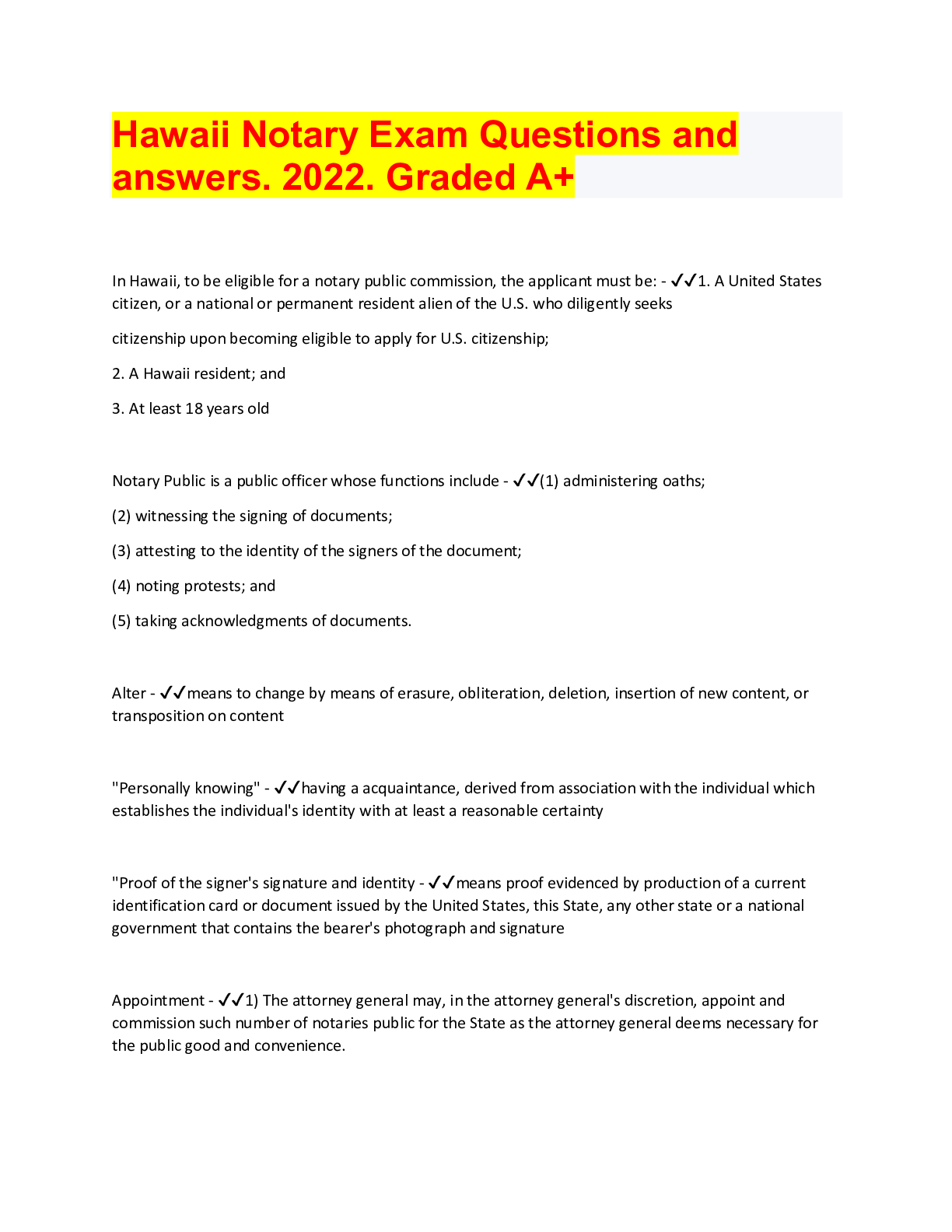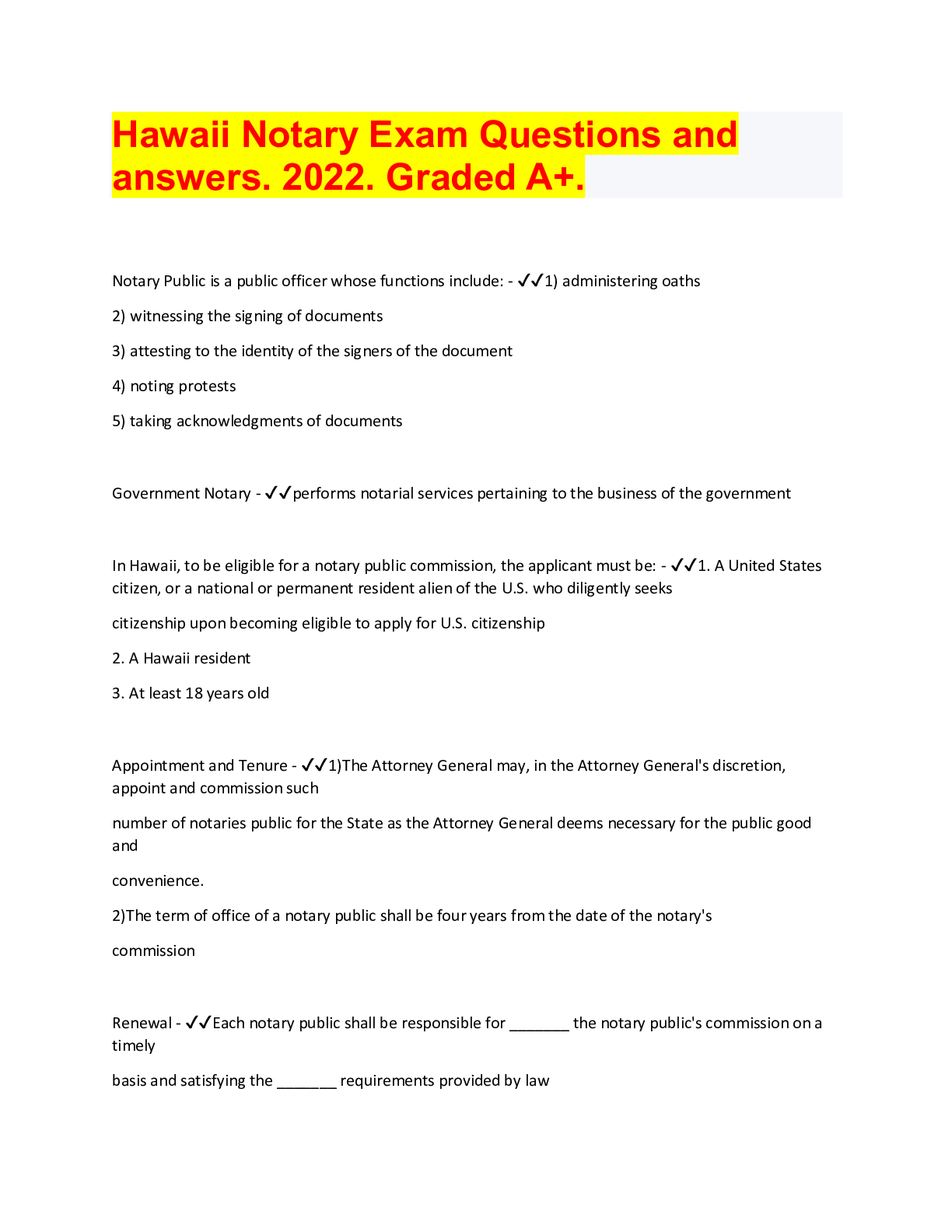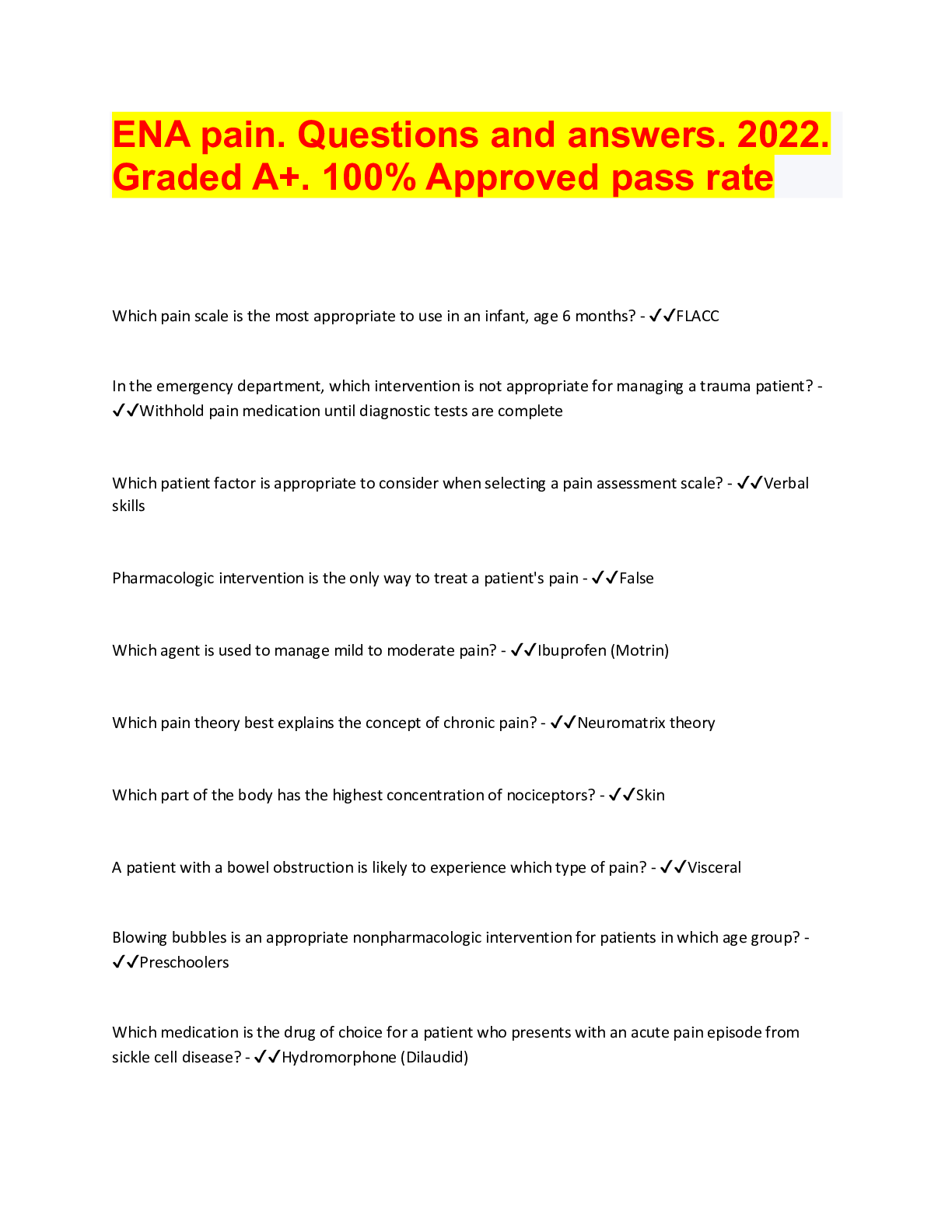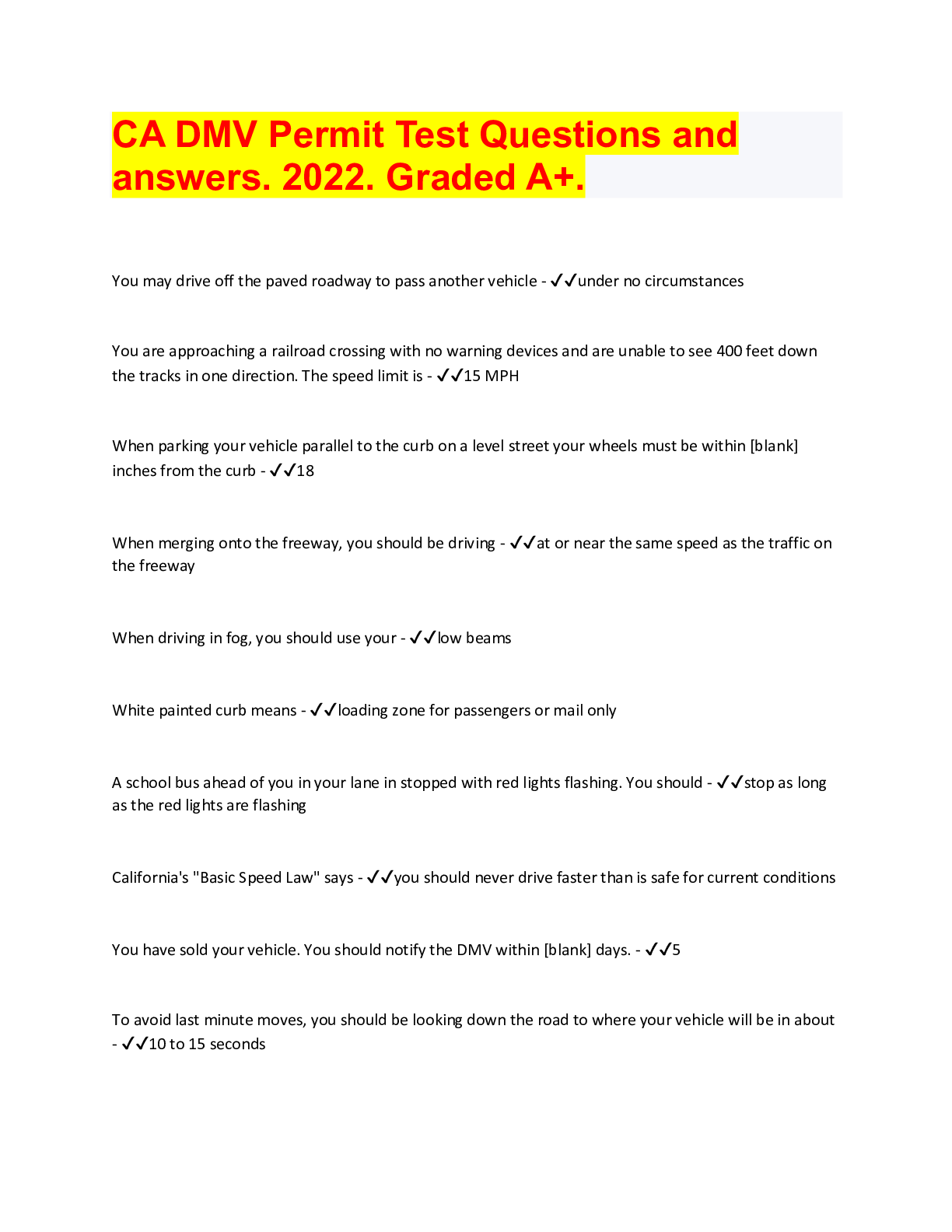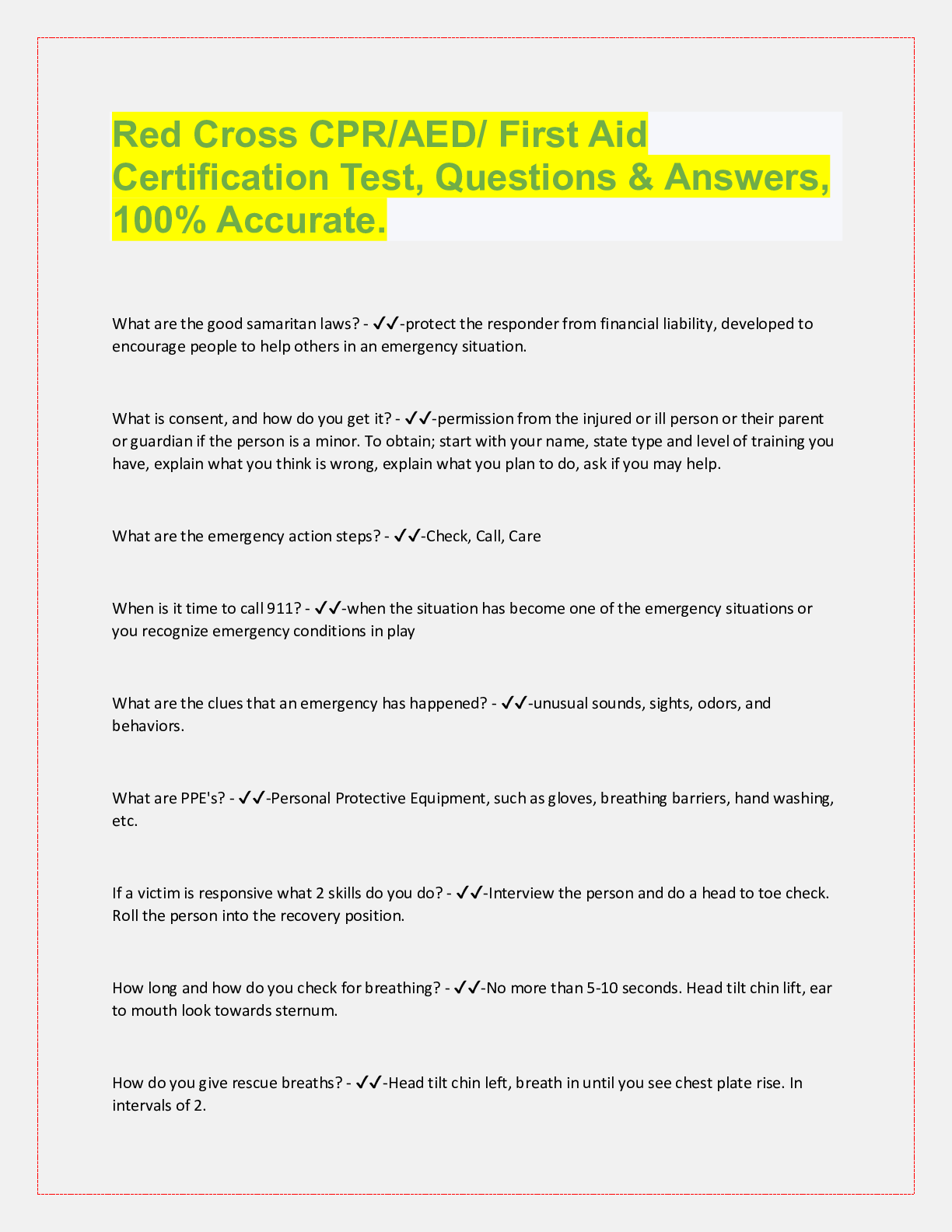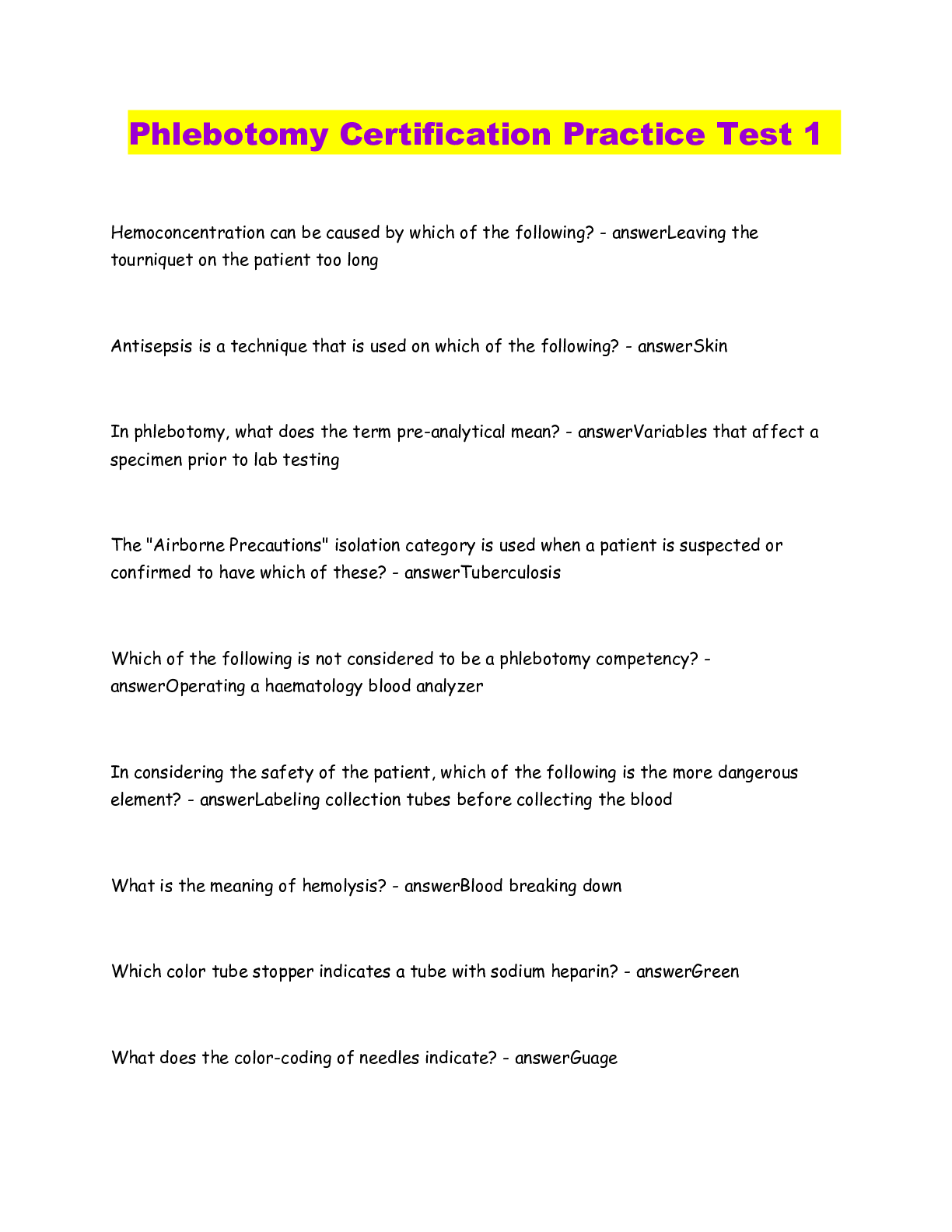*NURSING > QUESTIONS & ANSWERS > UVA Family Medicine Questions with answers. 2022. Graded A+ (All)
UVA Family Medicine Questions with answers. 2022. Graded A+
Document Content and Description Below
UVA Family Medicine Questions with answers. 2022. Graded A+ 1. A 50 year old female with a ten year history of type II diabetes presents for regularly-scheduled follow up. She has no complaints, ... and just visited her ophthalmologist last week. Current medications include glyburide, metformin, and simvastatin. On physical exam, vital signs are virtually unchanged from previous visits, with temperature 37.1 C (99 F), HR 80, BP 140/83, RR 15, and O2 Sat 98% on room air. Neurological examination reveals diminished sensation to light touch and pinprick in a stocking distribution on the lower extremities bilaterally. Remainder of physical exam is benign. Laboratory evaluation reveals: Na+ 136, K+ 3.9 Cl- 104, HCO3- 25, BUN 15, Cr 1.0, Glucose 150; hemoglobin A1c: 7.1%; Urinalysis: negative for ketones, glucose, bilirubin, leukocyte esterase, or blood; moderate protein; Lipid profile: Total cholesterol 146, HDL 46, LDL 100. At this time, which of the following would be the most appropriate intervention? A. Increase simvastatin B. Increase glyburide C. Increase metformin D. Add HCTZ E. Add lisinopril - ✔✔E. Add lisinopril All diabetics should be on ACE inhibitor or ARB for CV and renal protection LDL target in patients with known coronary heart disease - ✔✔<100 All diabetics should have a systolic less than? - ✔✔130 2. A 55 year old female comes to the emergency department complaining of a headache for the past six hours. Her headache began abruptly after she finished eating breakfast, and quickly increased to 8/10 throbbing pain located mainly over her right temple. The pain has been associated with mild nausea but no vomiting. She denies chronic or recurrent headaches, but did have one headache similar to this one two weeks ago, which resolved after taking ibuprofen and lying in a quiet, dark room. She has smoked one pack of cigarettes daily for 38 years. On physical exam, the patient has temperature of 37.0 C (98.6 F), pulse of 99, and BP 147/95. Neurological examination is nonfocal, but mild photophobia and nuchal rigidity are noted. Fundoscopic examination reveals no papilledema. Skin exam shows no lesions. CT of the head, obtained without contrast, reveals no abnormalities. What is the most appropriate next step in the management of this patient? A. Obtain head CT with contrast B. Lumbar puncture C. Administer im sumatriptan D. Administer oral ibuprofen E. Administer IV ceftriaxone - ✔✔B. Lumbar puncture 4. A 30 year old female presents to her physician with a breast mass. She first noted a small "lump" in her left breast while showering about six weeks ago. She has noted no change in the size of the mass since that time, and she denies pain or nipple discharge. Family history is significant for a paternal grandmother who had breast cancer at age 79. Physical examination reveals a soft, round, mobile 1cm mass in the lower outer quadrant of the left breast. No skin changes are noted. What is the most appropriate next step in the management of this patient? A. Mammography B. Refer patient for radical mastectomy C. Begin levonrgestrel/etinyl estradiol D. Genetic testing for BRCA1 and BRCA2 E. Ultrasound of breast mass - ✔✔E. Ultrasound of breast mass Mammogram is the preferred imaging study for women over 35, while women younger than 35 should get ultrasound to evaluate a breast mass. In women younger than 35, the breast tissue is often too dense to evaluate mammographically, and the incidence of breast cancer younger women is still very low. 5. An otherwise healthy 8 year old girl presents with two weeks of perianal pruritis. She has two younger brothers, one of whom has had similar complaints for the past few days. Physical exam reveals perianal erythema with mild excoriations. The "scotch tape test" reveals several bean-shaped white eggs. What is the most likely diagnosis in this patient? A. Trichuriasis B. Enterobiasis C. Child abuse D. Fecal soliage E. Atopic dermatitis - ✔✔B. Enterobiasis This is a classic case of enterobiasis (answer B) or "pinworm." The most common presenting symptom is intense anal itching or pruritus ani. Other symptoms (such as abdominal pain/fullness or nausea and vomiting) may occur if the worm burden is high. Girls may also present with a vulvovaginitis or urinary tract infection if the worms migrate. Eosinophilic enterocolitis and appendicitis are rarer complications. First line treatment for enterobiasis? - ✔✔Mebendazole Albendazole 6. A 66 year old male presents to the emergency department with chest pain. The pain began two hours ago as the patient was watching television. The pain is described as "squeezing" and is located primarily substernally with radiation to the jaw. Past medical history includes diabetes mellitus, hypertension, hyperlipidemia, and a 50 pack/year smoking habit. On physical exam, the patient appears anxious and diaphoretic. The patient is given supplemental oxygen by nasal cannula, and aspirin, morphine, and nitroglycerin are administered. EKG obtained on presentation to the ED is shown. Of the following, which is the most appropriate study to obtain next? A. Aortogram B. Troponin I C. Stress echo D. Exercise stress test E. CT angiogram of chest - ✔✔B. Troponin I To evaluate ACS, EKG + serial troponins 7. A 73 year old male presents to his physician complaining of cough and fatigue. His cough began 6 months ago and has steadily worsened, and is now associated with occasional expectoration of mucus streaked with bright red blood. Patient has also noted worsening dyspnea on exertion and a weight loss of 15 lbs. The patient has smoked a pack and a half of cigarettes every day for the past 60 years. Past medical history is significant for bipolar disorder treated with lithium. Physical exam shows unilateral localized wheezing on the left chest and clubbing of the distal extremities. Capillary refill is brisk. No skin tenting is observed. Chest X-ray is obtained, which shows a large mass at the left hilum. Labs show: Glucose 130, Na+ 125, K+ 4.0, Cl- 91, HCO3- 25, BUN 15, Creatinine 1.0; Plasma osmolality 270 (Normal: 282-295 mOsm/kg); Urine osmolality 650 mOsm/kg (Normal: 50 - 1400 mOsm/kg). Which of the following is the most likely mechanism for this patient's hyponatremia? A. Increased oral intake of hypotonic fluids B. Decreased oral intake of solutes C. Impaired secretion of ADH in the posterior pituitary D. Ectopic overproduction of vasopressin E. Resistance to ADH action on the cortical and medullary collecting tubules - ✔✔D. Ectopic overproduction of vasopressin When you see euvolemic hyponatremia (especially on the USMLE), think SIADH! The constellation of findings in this patient, including euvolemic hyponatremia, hypotonicity (plasma osmolality <280 mOsms), inappropriately concentrated urine, and normal renal function are diagnostic for the syndrome of inappropriate ADH secretion (SIADH). SIADH has a number of causes. Most common causes of SIADH - ✔✔1) Cancer - ectopic production of ADH by small cell lung cancers or pancreatic malignancies 2) CNS disturbances - traumatic injuries, strokes, infections, and hemorrhages can all cause increased ADH production 3) Drugs - most commonly caused by antipsychotic medications or chemotherapeutics, but the old (and seldom used) insulin secretagogue chlorpropamide is a commonly-tested causative agent 8. A 25 year old student presents with three days of vulvar pruritis. She has had a total of six lifetime partners, and is currently sexually active with one partner and states that they "occasionally" use condoms. One year ago, she was successfully treated for a Chlamydia infection. The patient denies vaginal odor or increased vaginal discharge. Physical exam reveals slight vulvar erythema, and speculum exam shows moderate clumpy white discharge. Vaginal discharge pH is 4.0. Whiff test is negative. Wet mount results: KOH prep shows occasional budding yeast and hyphae. Saline prep shows 3 WBCs, occasional squamous cells, and no bacteria. What is the next best step in the management of this patient? A. Clotrimazole vaginal cream B. Azithromycin and recommend that her partner see a physician for Chlamydia screening and treatment C. Metronidazole D. Ceftriaxone E. Reassurance and f/u in 2 weeks - ✔✔A. Clotrimazole vaginal cream This is a classic case of vulvovaginal candidiasis, which is usually treated with a single dose of oral fluconazole or several days of miconazole or clotrimazole vaginal creams Signs/symptoms yeast infection - ✔✔vulvar pruiritis, which is often the dominant feature of a yeast infection (and may be the only complaint from the patient). Other symptoms could include dysuria, vulvovaginal irritation, or dyspareunia. Classically, the discharge of a yeast infection is described as white with a curd-like consistency (often described as "cottage cheese" like), but many real-life patients will not complain of increased discharge. Low pH of vaginal discharge (<4.5) points to - ✔✔Yeast Which infections cause a more alkaline vaginal discharge? - ✔✔Trichomoniasis Bacterial vaginosis How to confirm yeast infection - ✔✔The diagnosis of candidiasis should be confirmed by finding budding yeast and hyphae on the 10% KOH wet mount. Uncomplicated yeast infection? - ✔✔Infections are uncomplicated when the patient experiences mild to moderate symptoms, the infections are sporadic, the suspected organism is Candida albicans, and the host is otherwise healthy. Complicated yeast infections? - ✔✔infection occurring in a host with pre-existing conditions (uncontrolled diabetes, immunosuppression, pregnancy), severe symptoms, infection with non-albicans species, or recurrent infections (>4 per year) BV discharge: - ✔✔Malodorous, thin, grey-white Trichomoniasis discharge: - ✔✔Purulent, green-grey, frothy When is the whiff test positive? - ✔✔BV Trich Saline wet mount for BV shows? - ✔✔Increased numbers of coccobacilli Clue cells (vaginal epithelial cells studded by adherent coccobacilli around the cell's edges) Saline wet mount for trichomoniasis will show? - ✔✔Motile trichomonads When is a ceftriaxone injection used for STDs? - ✔✔Acute gonorrhea Gonorrhea most commonly presents as: - ✔✔Cervicitis, urethritis or proctitis Speculum exam with gonorrhea: - ✔✔cervix is often friable and cervical discharge may be seen Gold standard for gonorrhea diagnosis? - ✔✔Thayer-Martin medium 9. A seven year old female is brought to the physician by her mother because of facial swelling and dark, cola-colored urine. These symptoms began abruptly two days ago and have been associated with anorexia and malaise. There have been no known sick contacts. Her mother states that the child is up to date with her immunizations and has been in good health except for a runny nose and sore throat around two weeks ago, which resolved after a few days without treatment. Vital signs are temperature 37.2 C (98.9 F), heart rate 95, and blood pressure of 148/86. There is diffuse edema of the lower extremities, face, and eyelids. Lungs and heart are clear to auscultation. Urinalysis shows moderate hematuria and proteinuria, and dysmorphic RBCs and occasional RBC casts are noted on microscopic examination. Based on these findings, what is the most likely diagnosis? A. IgA nephropathy B. Alport syndrome C. Thin basement membrane nephropathy D. Postinfectious glomerulonephritis E. Henoch-Schonlein purpura - ✔✔D. Postinfectious glomerulonephritis 1. Age <7 years old 2. Dark brown urine (hematuria) 3. Periorbital and peripheral edema Postinfectious glomerulonephritis latent period? - ✔✔Around 10 days for pharyngitis *for glomerulonephritis following streptococcal impetigo, the latent period can be as long as 3-4 weeks Anti-streptolysin O titer - ✔✔Positive in postinfectious glomerulonephritis, indicates recent exposure to Group A strep When there are casts in the urine sediment, you know it is ______ - ✔✔Glomerular disease (it's only when cells get squeezed through the glomerulus that they will form casts) What kind of RBC finding is highly suggestive of glomerular disease - ✔✔Dysmorphic RBCs (especially acanthocytes) Most common cause primary glomerulonephritis? - ✔✔IgA nephropathy Most common presentation IgA nephropathy? - ✔✔Recurrent episodes of gross hematuria that occur around 5 days after an upper respiratory infection. How to confirm diagnosis of IgA nephropathy - ✔✔Renal biopsy IgA nephropathy course? - ✔✔Most benign ACE/ARBs can minimize glomerular injury if disease progresses Key features of Alport Syndrome - ✔✔Glomerular hematuria Sensorineural deafness Ocular abnormalities Genetics of Alport Syndrome: - ✔✔Genetic mutation in collagen type IV Thin basement membrane nephropathy features: - ✔✔Ususally hereditary and benign Glomerular hematuria Minimal-moderate proteinuria can be seen occasionally How is thin basement membrane nephropathy most common detected? - ✔✔Routine UA (patients usually completely asymptomatic) Classic triad henoch-Schonlein purpura: - ✔✔Abdominal pain Vasculitic, raised skin rash Renal involvement Buzzword for Henoch-Schonlein purpura - ✔✔Palpable purpura Renal findings in Henoch-Schonlein purpura - ✔✔Variable, but include: Hematuria Proteinuria Rising creatinine 10. A 71 year old male comes to his physicians office complaining of muscle weakness. The weakness began insidiously several weeks ago, and has now progressed to the point where he has difficulty with normal activities such as brushing his hair or sitting unsupported. Past medical history is significant for hyperlipidemia, chronic renal insufficiency, coronary artery disease, and coronary artery bypass and grafting. Current medications include atorvastatin, fosinopril, metoprolol, aspirin, and spironolactone. Physical examination reveals diminished deep tendon reflexes and decreased motor strength. Laboratory evaluation shows Na+ 143, K+ 7.4, Cl- 101, HCO3- 28, BUN 30, and creatinine 1.8. EKG is obtained on presentation and is seen here. What is the most appropriate initial step in the management of this patient? A. Administer IV insulin and glucose B. Administer po sodium polystyrene sulfate C. Administer IV sodium bicarb D. Administer IV calcium gluconate E. Urgent hemodialysis - ✔✔D. Administer IV calcium gluconate Effect of calcium gluconate with hyperkalemia? - ✔✔Although this does not affect the serum K+ concentration, calcium does decrease cardiac membrane excitability and provide short-term cardioprotection from the membrane depolarizing effects of hyperkalemia When do most patients start to show symptoms of hyperkalemia? - ✔✔Above 7.0 Muscle weakness progressing to flaccid paralysis Description of a true peaked T wave - ✔✔Should be sharp enough to really hurt if you sat down on it (lol) What meds cause a shift of K+ from the serum into cells? - ✔✔Insulin + glucose Sodium bicarb When do you do urgent hemodialysis for hyperkalemia? - ✔✔Refractory cases Ongoing release of K+ from injured cells (ex: severe myonecrosis) 11. A 30 year old female comes to her physician's office for a routine health examination. She has been in good health recently and is up to date with her gynecological examinations. Her only medication is loratadine for seasonal allergies and ibuprofen for occasional headaches. Physical examination shows temperature 37.1 C (98.8 F), pulse 80, BP 170/92, RR 14, oxygen saturation of 99% on room air. A 3/6 mid-systolic ejection murmur is present. Abdomen is nontender with a soft systolic-diastolic bruit that lateralizes to the left side. The patient is grossly intact neurologically, and fundoscopic examination shows sharp optic disc margins. Laboratory evaluation shows Na+ 141, K+ 3.9, Cl- 106, HCO3- 27, BUN 18, Cr 1.0, glucose 98. Urinalysis shows trace proteinuria and no casts. What is the most likely pathological mechanism causing this patient's hypertension? A. Fibromuscular dysplasia B. Oversecretion of aldosterone C. Exogenous administration of corticosteroids D. Atherosclerotic disease E. Catecholamine-producing tumor - ✔✔A. Fibromuscular dysplasia Key clues for renal artery stenosis? - ✔✔Markedly elevated BP in otherwise healthy young person Abdominal bruit Classic features of fibromuscular dysplasia: - ✔✔Females under 50 When should you consider a diagnosis of secondary HTN? - ✔✔known onset of hypertension before age 30, patients whose blood pressure remains elevated despite multiple medications, patients who have severe (>160/100 mm Hg) hypertension above age 55, or patients with a sudden increase in their blood pressure from a stable baseline Disease in which there is an oversecretion of aldosterone? - ✔✔Primary hyperaldosteronism (Conn's syndrome) Presentation in Conn's syndrome: - ✔✔Hypokalemia HTN Key features of Cushing's: - ✔✔obesity, bone loss, glucose intolerance, moon facies, a "buffalo hump," purple striae, and hypertension Classic triad of pheochromocytoma: - ✔✔Episodic headache Sweating Tachycardia 12. A 23 year old male presents with syncope. He reports that while walking briskly to his car, he felt his heart "racing" in his chest, and shortly thereafter passed out. The patient denies any prior syncopal episodes, but does note occasional episodes of palpitations that occur after moderate activity or during periods of increased stress. There is no family history of neurological disease, cardiac disease, or sudden cardiac death. On physical examination, pulse is 85 and regular, BP is 124/74, respiratory rate is 16, and oxygen saturation is 98% on room air. Cardiac examination reveals pulsation at the fifth intercostal space at the left parasternal area in the midclavicular line. S1 is within normal limits, and S2 is heard to split on inspiration. The remainder of the physical exam is unremarkable. EKG taken in the office shows the following tracing in lead II. Which of the following would be the most appropriate treatment for this patient's disorder? A. Radiofrequency ablation of pre-excitation pathway B. Urgent DC cardioversion C. Heart transplant D. Biventricular pacemaker placement E. Coronary angioplasty - ✔✔A. Radiofrequency ablation of pre-excitation pathway Pathophysiology of WPW syndrome - ✔✔presence of an "accessory pathway," an abnormal conduction pathway that allows electrical impulses from the SA node to reach the ventricle without having to conduct through the AV node. Normal conduction through the AV node is slower than conduction through this accessory or "pre-excitation" pathway, so the ventricle gets activated at different times by the two different pathways Pathognomonic EKG finding at rest with WPW: - ✔✔Delta wave PE findings with WPW: - ✔✔Few or no findings is not uncommon Rhythm disturbances in which urgent DC cardioversion is indicated: - ✔✔V tach V fib *may be indicated with new-onset a fib When is biventricular pacemaker placement indicated? - ✔✔Symptomatic bradyarrhythmias SA or AV node dysfunction 13. A 20 year old healthy female presents to her family physician for routine annual gynecological exam. She is sexually active with her monogamous male partner and currently uses the withdrawal method for contraception. Although this is her first sexual partner, she thinks her boyfriend has probably had intercourse with other women prior to their relationship. Her LMP was 2 days ago. She agrees to routine gonorrhea and Chlamydia testing. On speculum exam after swabbing for the test, some bleeding from the cervical mucosa is noted. Bimanual exam is normal. The test returns positive for N. gonorrheae. What is the best initial step in the management of this patient? A. Reassurance and encourage condom use B. Start an oral OCP C. Ceftriaxone and azithromycin D. Doxycycline E. Ciprofloxacin - ✔✔C. Ceftriaxone and azithromycin Which sex is gonorrhea more likely to be asymptomatic in? - ✔✔Females Gonorrhea screening: - ✔✔All sexually active females <25 years old When can you not use fluoroquinolones? - ✔✔Pregnant women --> fetal toxicity Peds --> arthrotoxicity Doxycycline dose when treating chlamydia? - ✔✔One week Speculum exam with cervicitis - ✔✔Friable cervix 14. A 74 year old man presents with double vision. He first noticed this several months ago, and although his symptoms wax and wane, he now experiences daily episodes of "seeing double," most frequently in the evenings. He also reports increased generalized fatigue and notes that he sometimes gets so tired at dinner that he "can hardly chew" his food. Past medical history includes osteoarthritis, hypertension, and abdominal aortic aneurysm repair. Physical examination reveals a comfortable, age-appropriate elderly gentleman with mild dysarthria. Cardiac auscultation reveals both an S4 and a 2/6 holosystolic murmur heard best at the left upper sternal border with radiation to the carotids. On neurologic exam, the patient has 5/5 strength proximally and distally. Sensation is intact and reflexes are 2+ throughout. Ocular movements are sluggish but intact in all directions. The patient has mild bilateral ptosis, which is noted to increase with sustained upward gaze. Stroking the bottom of the foot results in downward deflection of the great toe bilaterally. Which of the following is the most appropriate next step in diagnosis? A. Administer IV edrophonium B. CT of the chest C. MRI/MRA of brain and cerebral vessels D. Temporal artery biopsy E. CSF examination for oligoclonal bands - ✔✔A. Administer IV edrophonium How to confirm diagnosis of myasthenia gravis? - ✔✔Edrophonium improves patient's symptoms AKA the Tensilon Test EMG findings in MG - ✔✔Decremental response to repetitive nerve stimulation Key features of MG - ✔✔Muscle weakness that gets worse throughout day Oculobular MG: - ✔✔Double vision Ptosis Dysarthria Difficulty chewing Who gets MG? - ✔✔Bimodal 1. Young women in 20s or 30s with another autoimmune disorder 2. Men in their 70s or 80s Pathophysiology of MG: - ✔✔Autoantibodies that bind to postsynaptic ACh receptors Lambert-Eaton is usually associated with? - ✔✔Small cell lung cancer Pathophysiology of Lambert-Eaton? - ✔✔Antibodies are produced against the pre-synaptic Ca2+ channels MG treatment - ✔✔Anticholinesterase drugs (neostigmine, pyridostigmine) Prednisone, immunosuppressives Treatment of refractory MG - ✔✔IV IG Plasmapharesis MG's association with another part of body? - ✔✔Thymus 75% have thymic hyperplasia 15% have overt thymoma (Removal can be curative in those failing medical treatment) When is chest CT indicated for MG? - ✔✔AFTER the primary diagnosis is made Classic presentation temporal arteritis - ✔✔Jaw claudication Vision loss Elevated ESR 15. On routine examination, a five year old child is noted to have a loud S1 with a fixed and widely split S2 that does not vary with respiration. A soft, mid-systolic ejection murmur is heard best on the left in the second intercostal space. Remainder of physical exam is otherwise unremarkable. There is no nail clubbing, hepatomegaly, or jugular venous distension. The child is healthy and active and her mother has no health concerns. Which of the following is the most likely diagnosis in this patient? A. Mitral valve prolapse B. Pulmonic regurg C. Tetralogy of fallot D. ASD E. VSD - ✔✔D. ASD ASD buzzword - ✔✔Fixed splitting of S2 Does ASD cause a murmur? - ✔✔NO! The resultant increased volume of blood going over pulmonary valve does --> flow or ejection murmur Murmur associated with increased flow across pulmonary valve - ✔✔Mid-systolic ejection murmur Left 2nd intercostal space Classic auscultory finding with MVP: - ✔✔Midsystolic click followed by a late systolic murmur Heart best @ apex Classic murmur of VSD: - ✔✔Low-pitched, harsh holosystolic Heard best at LLSB 16. A 62 year old woman with COPD presents to her physician complaining of two days of increasing dyspnea and cough. She uses supplemental oxygen at home and has had to increase her oxygen flow to relieve her shortness of breath. Recently, her cough has been productive of copious amounts of thick, dark yellow sputum. Although she never checked her temperature at home, she thinks she might have had a fever last night. Past medical history includes hypertension and peripheral arterial disease. She has smoked 1 1⁄2 -2 packs of cigarettes per day for the last 45 years and continues to smoke. Current medications include nebulized albuterol, tiotropium, inhaled fluticasone/salmeterol, lisinopril, and pentoxyfylline. Physical examination reveals an uncomfortable, thin female appearing older than her stated age. Vital signs are: temperature 37.2 C (99.0 F), pulse 80, blood pressure 136/70, respirations 20/min, oxygen saturation 88% on 2 L O2 by nasal cannula. The patient is using accessory muscles to breathe, and prolonged expirations and faint expiratory wheezes throughout the lung fields. Coarse crackles are heard at the lung bases. The patient's chest X-ray is shown. Which of the following is the most appropriate treatment for this patient? A. Methylprednisolone B. Prednisone and amoxicillin C. Guaifenasin D. Trimethoprim/sulfamethoxazole E. Aminophylline - ✔✔B. Prednisone and amoxicillin Most common abx for COPD exacerbations - ✔✔Amoxicillin Bactrim Doxycycline Classic COPD CXR - ✔✔hyperexpanded lungs, flattened diaphragms, and a narrow cardiac silhouette Interventions that prolong life in COPD - ✔✔Smoking cessation Supplemental O2 17. A 64 year old male presents for routine health evaluation. He has been feeling well and has no complaints. Past medical history includes hypertension, osteoarthritis, and generalized anxiety disorder. Medications include hydrochlorothiazide, ibuprofen, atenolol, and paroxetine. Physical exam shows temperature 37.9 C (99.3 F), pulse 61, blood pressure 131/70, and respirations 15/min. Laboratory evaluation shows: Na+ 141; K+ 3.9; Cl- 103; HCO3- 25; BUN 18; Creatinine 1.2; WBC 9.7; Hemoglobin 10.1; Platelets 179; MCV 73 fL. Which of the following is the most appropriate next step in the management of this patient? A. Add lisinopril B. Measure reticulocyte count C. Test B12/folate D. Endoscopy E. Indirect and direct coombs test - ✔✔D. Endoscopy Mnemonic for microcytic anemias: TAILS - ✔✔Thalassemias Anemia of chronic disease Iron deficiency Lead poisoning Sideroblastic Indications for any male or postmenopausal woman with iron deficiency anemia: - ✔✔Evaluated for occult GI source, preferably with upper and lower endoscopy ALL microcytic anemias are caused by: - ✔✔Impaired incorporation of hemoglobin into RBCs Lab findings with antibody-mediated hemolysis? - ✔✔Normocytic anemia Elevated retic count Increased LDH and bilirubin Decreased haptoglobin 18. A 36 year old African-American male comes to the clinic complaining of fatigue and dark, cola-colored urine for the past five days. He denies fever, nausea or vomiting, recent travel, and i.v. drug use. Past medical history includes ulcerative colitis. Medications include sulfasalazine as well as trimethoprim/sulfamethoxazole which the patient began taking one week ago for a presumed Staphylococcal skin infection. Vital signs are temperature 36.8 C (98.2 F), pulse 78, blood pressure 118/72, respirations 14/min. Physical examination shows scleral icterus and a nontender abdomen without organomegaly. Laboratory evaluation shows: WBC 8.6; Hgb 9.1; Hct 27.3; Platelets 212; MCV 88 fL; Na+ 144; K+ 4.8; Cl- 101; HCO3- 26; BUN 14; Creatinine 1.0; Glucose 101; LDH 410 U/L; Haptoglobin 8 mg/dL. Which of the following is the most appropriate next step in management of this patient? A. Quantitative IgM for hepatitis A virus B. Begin darbopoietin injections C. Begin methylprednisolone D. Discontinue trimethoprim/sulfamethoxazole E. Immediate transfusion of packed red blood cells - ✔✔D. Discontinue trimethoprim/sulfamethoxazole Best way to diagnose acute hep A? - ✔✔Quantitative IgM Jaundice due to hemolysis? - ✔✔Elevated LDH Low haptoglobin G6PD deficiency genetics/epidemiology - ✔✔X-linked recessive disease that tends to affect men of Mediterranean or African descent Most common causes of increased oxidative stress and hemolysis? - ✔✔Infection (viral, bacterial) Fava beans Nitrofurantoin Quinine Dapsone Sulfonamides Treatment of autoimmune hemolytic anemias - ✔✔Corticosteroids 19. A 65 year old female with diabetes is found on routine screening to have a total serum cholesterol concentration of 198 mg/dL, with a serum HDL cholesterol of 58 mg/dL and serum LDL cholesterol of 128 mg/dL. Triglycerides are 78 mg/dL, and last hemoglobin A1c is 6.5%. The patient has no known history of coronary artery disease, does not smoke, and exercises daily. Current medications include rosuvastatin, fosinopril, glyburide, and metoprolol. Blood pressure is 129/78. Urinalysis shows no protein. Which of the following is the best management plan and treatment goal for this patient? A. Add niacin to increase HDL to >80 mg/dL B. Increase rosuvastatin to target LDL <100 mg/dL C. Add gemfibrozil to decrease triglycerides to <70 mg/dL D. Discontinue fosinopril and add hydrochlorothiazide to decrease blood pressure to <120/80 E. Begin insulin therapy to target Hgb A1c <6.0% - ✔✔B. Increase rosuvastatin to target LDL <100 mg/dL Risk factors in elevated LDL - ✔✔Blasting cigs FH of premature CV death Low HDL <40 HTN Patient's with 2+ LDL risk factors= - ✔✔Goal of less than 130 Patient's with zero or one LDL risk factor - ✔✔LDL goal of less than 160 Catch with LDL goals: - ✔✔Patient's with known CAD --> less than 100 Equivalents=cerebrovascular disease, AAA, PAD, diabetics (Goal of less than 70 in VERY high risk patients) Which medication has profound effects on HDL? - ✔✔Niacin (statins and fibrates modestly raise) A1C of 7.0 correlates to - ✔✔Mean glucose level of less than 150 20. A 5 year old female presents for a pre-kindergarten physical and is found to have a blood pressure of 146/85 in both arms. Past medical history is unremarkable, and the child has been healthy and asymptomatic. Physical examination reveals a short, stocky female with a broad, shield shaped chest and widely-spaced nipples. There are diminished femoral pulses bilaterally. On cardiac auscultation, a short 2/6 midsystolic murmur is heard at the left paravertebral interscapular area. Which of the following is the most likely associated finding in this patient? A. Increased urine homovanillic acid (HVA) and vanillylmandelic acid (VMA) B. Tonsillar hypertrophy C. Decreased levels of thyroid stimulating hormone (TSH) D. Chest x-ray showing notching of the ribs bilaterally E. Sensorineural hearing loss and hematuria - ✔✔D. Chest x-ray showing notching of the ribs bilaterally How does rib notching on CXR form? - ✔✔Development of arterial collaterals (through the intercostal arteries in an attempt to bypass the blockage in the aorta) Turner's buzzwords - ✔✔Short, squat female Webbed neck Shield shapped chest Widely spaced nipz Turner's presentation - ✔✔Short stature Primary amenorrhea Lab findings with neuroblastoma? - ✔✔Increased HVA and VMA *But NOT urine metanephrines and normetanephrines as are seen in pheochromocytomas Common cause of secondary HTN in children - ✔✔OSA due to tonsillar hypertrophy 21. An 84 year old woman has experienced three weeks of diffuse myalgias. In addition to worsening fatigue, she has stiffness upon awakening in her shoulders, hip girdles, neck, and torso. The stiffness usually resolves after several hours. She has also had occasional low-grade fevers and a 6 pound weight loss since her symptoms began. Physical examination shows decreased active range of motion of the shoulders and neck, but no muscle tenderness. Neurological exam shows normal sensation and reflexes. No abnormal findings are noted on skin examination. Which of the following is the most likely associated finding in this patient's disease? A. Anti-centromere antibodies positive at 1:640 B. Absolute neutrophil count of 950/mm3 (Normal: >1800 mm3) C. Karyotyping showing t(9,22) chromosomal rearrangement D. Erythrocyte sedimentation rate (ESR) of 96 mm/h (Normal: <20 mm/h) E. X-rays demonstrating expansion of the bony cortex in a mosaic pattern - ✔✔D. Erythrocyte sedimentation rate (ESR) of 96 mm/h (Normal [Show More]
Last updated: 1 year ago
Preview 1 out of 94 pages

Buy this document to get the full access instantly
Instant Download Access after purchase
Add to cartInstant download
We Accept:

Also available in bundle (1)

Family medicine bundle, latest versions 2022.
All family medicine documents, questions wityh answers, graded A
By bundleHub Solution guider 1 year ago
$22
9
Reviews( 0 )
$13.00
Document information
Connected school, study & course
About the document
Uploaded On
Aug 18, 2022
Number of pages
94
Written in
Additional information
This document has been written for:
Uploaded
Aug 18, 2022
Downloads
0
Views
102












